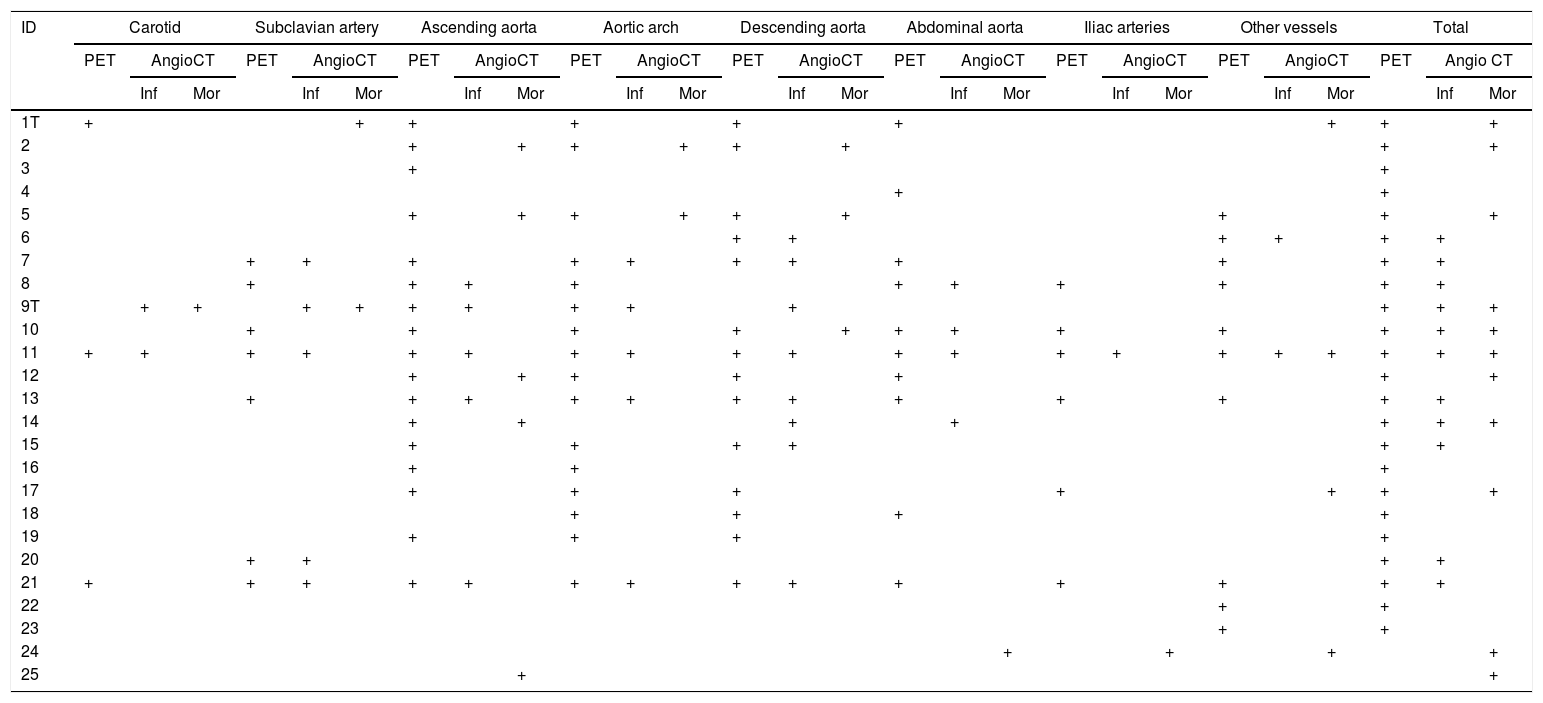Compare 18F-FDG PET/CT and CTangio in the diagnosis of extracraneal large vessel involvement in patients with suspicion of large vessel vasculitis (LVV).
Material and methodsA retrospective database reviewed 59 patients with clinical suspicion of LVV undergoing 18F-FDG PET/CT and CTangio. In 55 patients PET/TC and CTangio were done simultaneously in the same machine and in 4 patients with a scan interval of <1 month. PET/CT analyses included qualitatively and quantitative analysis (ratio SUVmax 118F-FDG vessel/SUVmax liver). CTangio was assessed for concentric mural thickening, contrast wall enhancement and structural vascular changes as potential complications of vasculitis.
Results18F-FDG PET/CT and CTangio show high specificity (97.2%) for LVV diagnosis, with an excellent sensitivity for 18F-FDG PET/CT (95.6%) and lower for CTangio (60.9%), which leads to a high negative predictive value for 18F-FDG PET/CT (97.2%) and a high false negative rate for CTangio (39.1%). A 70% concordance between 18F-FDG PET/CT and CTangio was obtained (Kappa index 0.70±0.095 (p<.001).
ConclusionThe results show the greater potential of 18F-FDG PET/CT for the detection and extension of LVV. Therefore, 18F-FDG PET/CT should be exploited to the maximum and consider as the first line imaging technique in the extracranial diagnosis of LVV and its possible association with polymyalgia rheumatica. The addition of CTangio could be more indicated in patients with Takayasu arteritis and in long-standing and/or severe vasculitis since it increases the accuracy in the detection of possible vascular complications.
Comparar la PET/TC con 18F-FDG y la angioTC en el diagnóstico de la afectación extracraneal en pacientes con sospecha de vasculitis de grandes vasos (VGV).
Material y métodoEstudio retrospectivo en 59 pacientes con sospecha clínica de VGV, estudiados con PET/TC con 18F-FDG y angioTC. En 55 pacientes la PET/TC y angioTC se realizaron simultáneamente en la misma máquina y en 4 pacientes en un interval <1 mes. La PET/TC se valoró cualitativamente y cuantitativamente (cociente SUVmáx 18F-FDG vaso/SUVmáx hígado). En la angioTC se valoró el engrosamiento mural, el realce de contraste en la pared del vaso y las complicaciones vasculares.
ResultadosLa PET/TC con 18F-FDG y la angioTC mostraron una elevada especificidad (97.2%) para el diagnóstico de VGV, con una excelente sensibilidad para la PET/TC con 18F-FDG (95.6%) y menor para la angioTC (60.9%), un alto valor predictivo negativo para la PET/TC con 18F-FDG (97.2%) y una alta tasa de falsos negativos para angioTC (39.1%). Se obtuvo una concordancia entre PET/TC con 18F-FDG y angioTC del 70% (índice Kappa 0,70±0,095) (p<0,001).
ConclusiónLos resultados demuestran un mayor potencial de la PET/TC con 18F-FDG para la detección y extensión de la VGV. La PET/TC con 18F-FDG debe considerarse como la exploración de primera línea en el diagnóstico extracraneal de VGV y su posible asociación con la polimialgia reumática. La angioTC podría estar más indicada en pacientes con arteritis de Takayasu y en vasculitis de larga duración y/o severas, al detectar las posibles complicaciones vasculares.
Artículo

Revista Española de Medicina Nuclear e Imagen Molecular (English Edition)
Comprando el artículo el PDF del mismo podrá ser descargado
Precio 19,34 €
Comprar ahora











